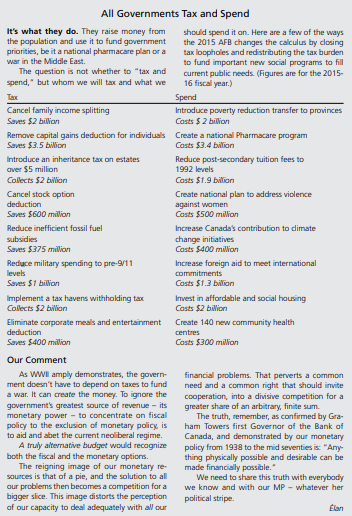By Jim Stanford, CCPA Monitor, May/ June 2015
With a document whose very timing, let alone content, was so transparently politicized and manipulative, it’s hard to even know where to start. Among the many galling, short-sighted, and ultimately destructive components of this federal budget, here are five that stand out in my view:
1. Timing. At a time of great economic uncertainty in Canada (arising from the sharp decrease in oil prices and growing evidence of serious economic trouble), the government chose to heighten the uncertainty by delaying its budget for several weeks. Turns out this was not because of uncertainty about oil prices. The delay was actually to wait until the fiscal year started, so they could sell the GM shares and use the net proceeds to help achieve the politically all-important “balance.” This gaming of the process (let alone the content) of fiscal policymaking was shameful and reckless.
2. Selling the Silverware. The $2.1 billion net proceeds from the sale of GM shares were essential to the government’s declared, and we should add quite small, surplus of $1.4 billion. The shares fetched $3.3 billion, but the government had to deduct their “book value,” which was artificially low due to the government’s ultra-cautious accounting in 2009 when it helped bail-out the firm.
The bigger outrage is that the seat at the GM director’s table was worth far more to Canada than the proceeds from the sale of shares, since it gave the government an indirect lever with which to assure the company’s continuing manufacturing presence here. The fire sale was widely interpreted in the automotive media as a sign that Canada was “giving up” on the industry, as another spate of articles tells of a new migration of auto investment to Mexico.
More fundamentally, selling an asset to balance a current budget makes the state poorer, not richer. Toby Sanger with the Canadian Union of Public Employees has argued that, based on consensus analyst forecasts, the government would have made an extra $1 billion by hanging on to its shares for just one extra year. Of course, that would be too late to help the government contest another election with a phony surplus to wave around.
The budget confirms the path of grinding, disguised austerity that has dominated fiscal policy under this government.

3. Phony Balance. The government’s “balanced budget” is entirely dependent on fiscal sleight-of-hand. On top of siphoning off $2.1 billion from the GM shares, the government diverted $2 billion out of its normal $3 billion contingency reserve. Apparently, things are so stable in the world economy these days t here’s no need for so much symbolic protection.
But perhaps most offensively of all, they raided $3.4 billion from the annual operating surplus of the Employment Insurance system. That EI surplus, by the way, is created because our system denies benefits to over 60% of unemployed Canadians. The appropriate fiscal response, especially with growing layoffs around the country, would be to fix that problem instead of raiding the EI cookie jar. It’s the response recommended in this year’s Alternative Federal Budget.
That makes a total of $7.5 billion in shell-game transactions. Without those three fiscal tricks, the reported balance would be a $6.1 billion deficit, not a $1.4 billion surplus. The emphasis placed on achieving balance is misplaced anyway, as many economists of all stripes have pointed out. But to attain this inappropriate “victory” in such an underhanded and misleading way sets a new low for the politicization of fiscal policy.
4. Public Transit. The opposition parties have argued that this is the moment for government to invest heavily in overdue infrastructure projects. This view is fully and loudly endorsed by economists around the world, who correctly identify secular stagnation (not public debt) as the greatest threat to prosperity and stability. The argument must be having some effect on public opinion: a recent poll indicated Canadians preferred infrastructure spending over tax cuts by more than two to one.
This government has responded to this pressure with some mostly token infrastructure initiatives in the 2015 budget. The Public Transit Fund, for example, gets several pages of text in the budget plan. But you have to wade through many tables until you realize it doesn’t get any money until the 2017–18 fiscal year, and then it’s only $250 million. Given the high cost of transit investments, and how desperately we need them (for economic, social and environmental reasons), this is offensive. I am amazed Joe Oliver could announce it with a straight face.
5. More Stealth Austerity. Even many critics of the government are describing the budget as full of tax cuts and other “election goodies.” This is a mischaracterization. Some of the tax cuts are new and, therefore, taking up air time. Combined with the Family Tax Cut announced last year they are also way too expensive, costing $5 billion just this year. These cuts will have a perverse impact on equality, labour force participation and other variables, as some articles have pointed out. But the real thrust of the budget won’t make the headlines because it’s just “more of the same,” which isn’t traditionally newsy. The budget confirms the path of grinding, disguised austerity that has dominated fiscal policy under this government. Federal public administration employment has decreased by 50,000 positions since mid-2011. The government has imposed incremental, poorly understood spending cuts that cumulate to $14 billion per year. It has underfunded veterans’ offices, coast guard facilities, meat and railway inspectors, EI processing, and many other services that are essential to the quality and safety of our lives. The government will unilaterally reduce health transfers to the provinces beginning in 2017 by $36 billion over a decade. It will force Canadians to work until age 67 to collect Old Age Security.
These painful and unnecessary measures are significantly undermining the quality and cohesion of Canadian society. Their silent confirmation in this budget is its dominant feature – not the pre-election goodies the government hopes we will talk about all summer.
Our Comment
Isn’t the “gaming of…fiscal policy-making” one of the best things the government has going for it!
As for “selling the silverware,” this is at least one of the more open ways we are short-changed. Sleight-of-hand operations like dipping into the GM shares and the contingency reserve require the superior detection savvy of knowledgeable experts like Jim Stanford.
Robbing taxpayers seems to have become almost reputable – it’s so routine. However, to steal from the unemployed is surely a particularly despicable, all-time low!
Until we address the issue of monetary policy, only “token infrastructure initiatives” are to be expected. Fiscal policy cannot finance such costly investments. Besides, if you are not in control of your monetary policy, fiscal policy is nothing but a wish list.
Austerity is not an economic necessity; it’s a political choice. It is part of a political process that begins with the creation of money out of thin air, as debt, by private banks, and ends with the expropriation of the world’s real wealth by what the occupy movement has identified as the 1%.
Élan







